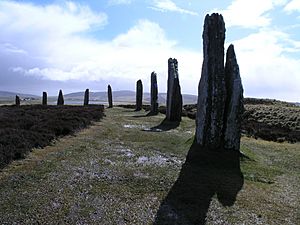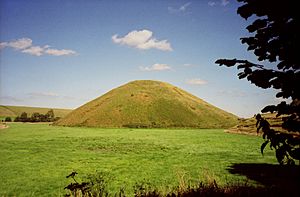Neolithic British Isles facts for kids

The Neolithic British Isles is about the ancient people who lived on these islands from about 4000 BC to 2,500 BC. These people left behind amazing stone monuments and other signs of their lives across Great Britain, Ireland, the Isle of Man, and many other smaller islands. This time was the last part of the Stone Age in the British Isles.
Contents
Amazing Ancient Sites
Some of the most important Neolithic places are now protected as UNESCO World Heritage Sites. This means they are very special and important to the whole world.
Life in the Neolithic British Isles
Before the Neolithic period, people in the British Isles were nomadic hunter-gatherers. This means they moved around a lot to find food. Around 4000 BC, new ideas came to the islands from Europe. These ideas changed how people lived, worked, and even how the land looked. This big change is sometimes called the Neolithic Revolution.
During the Neolithic, people started to farm and live in settled villages. They no longer had to move around constantly for food. To create new farmland, these early farmers cut down many trees, which changed the landscape a lot. They also started making new kinds of stone tools. These tools were often polished and needed new skills to create.
The Neolithic people built many large monuments. Many of these were megalithic, meaning they were made of huge stones. The earliest ones were chambered tombs, which were burial places. Later, they built stone circles, a trend that continued into the Bronze Age. These big structures were likely used for ceremonies and religious events. New ideas about beliefs and how society was organized came with this new way of life.
The people of the Neolithic period did not have writing. So, they left no written records. Everything we know about them comes from archaeological digs. This study started in the 1700s and grew in the 1800s. That's when John Lubbock first used the word "Neolithic." The work has continued to grow in the 20th and 21st centuries.
A Look Through Time
"The Neolithic period brought huge changes to landscapes, societies, and technology. It turned a wild, forested world into one with organized farms and settled communities. It was a time when new ideas, plants, and animals arrived, changing the native people of Britain. The Neolithic started a whole new chapter in human history. In Britain, it happened quite quickly, lasting only about 2000 years – which is just 80-100 generations of people."
Before the Neolithic: Late Mesolithic
During the Mesolithic period, Britain was still connected to Europe by a land bridge called Doggerland. An archaeologist named Caroline Malone said that during this time, the British Isles were a bit behind in technology compared to the rest of Europe. While much of southern Europe was already farming, people in Britain were still hunter-gatherers.
Early and Middle Neolithic: 4000–2900 BC
How Farming Spread
The first people to start farming instead of hunting and gathering lived in the Near East (around modern-day Middle East) between 8000–6000 BC. Similar changes happened later in other parts of the world, like China and Mesoamerica. The most important farming developments happened in the Levant and the mountains around what is now Syria, Israel, Jordan, Turkey, Iran, and Iraq. These areas had many different plants and animals that hunter-gatherers were already using.
Early signs of hunter-gatherers starting to collect and grow food plants have been found in the Mesolithic Natufian culture of the Levant. Archaeologists think that people in the Levant started farming between 8000 and 7000 BC. This was because their population grew, and hunting and gathering could no longer feed everyone. The idea of farming then spread from the Levant into Europe. It was adopted by hunter-gatherer groups in places like Turkey, Greece, and across the Mediterranean, eventually reaching north-western Europe and the British Isles.
The Neolithic Arrives in the British Isles
Archaeologists still discuss how the Neolithic way of life came to the British Isles. Some think that the native people learned farming from Europeans. Others believe that groups of European farmers migrated to the islands and settled there, bringing their new ideas with them.
Late Neolithic: 3000–2500 BC
After more than a thousand years of early farming, the way of life based on ancestral tombs, clearing forests, and growing settlements began to change. This was a time of important social shifts.
After the Neolithic: Early Bronze Age
The time period after the Neolithic is called the Bronze Age. This is because people started using bronze to make tools and other items.
Images for kids
-
The Neolithic chambered tomb of Newgrange in County Meath, Ireland. It was built around 3200 BCE.





